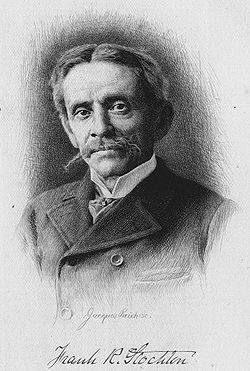
Frank R. Stockton
Encyclopedia

Maurice Sendak
Maurice Bernard Sendak is an American writer and illustrator of children's literature. He is best known for his book Where the Wild Things Are, published in 1963.-Early life:...
. "The Griffin and the Minor Canon" won a Lewis Carroll Shelf Award
Lewis Carroll Shelf Award
The Lewis Carroll Shelf Award was started in 1958 by Dr. David C. Davis with the assistance of Prof. Lola Pierstorff, Director Instructional Materials Center, Univ. of Wisconsin and Madeline Allen Davis, WHA Wisconsin Public Radio. Awards were presented annually at the Wisconsin Book Conference...
in 1963.
His most famous fable is "The Lady, or the Tiger?" (1882), about a man sentenced to an unusual punishment for having a romance with a king's beloved daughter. Taken to the public arena, he is faced with two doors, behind one of which is a hungry tiger
Tiger
The tiger is the largest cat species, reaching a total body length of up to and weighing up to . Their most recognizable feature is a pattern of dark vertical stripes on reddish-orange fur with lighter underparts...
that will devour him. Behind the other is a beautiful lady-in-waiting, whom he will have to marry, if he finds her. While the crowd waits anxiously for his decision, he sees the princess among the spectators, who points him to the door on the right. The lover starts to open the door and ... the story ends abruptly there. Did the princess save her love by pointing to the door leading to the lady-in-waiting, or did she prefer to see her lover die rather than see him marry someone else? That discussion hook has made the story a staple in English classes in American schools, especially since Stockton was careful never to hint at what he thought the ending would be (according to Hiram Collins Haydn in The Thesaurus of Book Digests, ISBN 0-517-00122-5). He also wrote a sequel to the story, "The Discourager of Hesitancy".
Life and career
Born in Philadelphia, Stockton was the son of a prominent MethodistMethodism
Methodism is a movement of Protestant Christianity represented by a number of denominations and organizations, claiming a total of approximately seventy million adherents worldwide. The movement traces its roots to John Wesley's evangelistic revival movement within Anglicanism. His younger brother...
minister who discouraged him from a writing career. After he married Mary Ann Edwards Tuttle, the couple moved to Nutley, New Jersey
Nutley, New Jersey
2010 Census Data:*TOTAL: 28,370 or 100%*White: 23,405 *African American: 628 *Asian: 2,824 *American Indian and Alaska Native: 36 *Native Hawaiian and Pacific Islander: 4...
.
For years he supported himself as a wood engraver until his father's death in 1860; in 1867, he moved back to Philadelphia to write for a newspaper founded by his brother. In 1867, he moved back to Philadelphia to write for a newspaper founded by his brother. His first fairy tale, "Ting-a-ling," was published that year in The Riverside Magazine; his first book collection appeared in 1870.
Further reading
- Jack ZipesJack ZipesJack David Zipes is an American retired Professor of German at the University of Minnesota, who has published and lectured on the subject of fairy tales, their evolution, and their social and political role in civilizing processes...
, editor, Fairy Tales of Frank Stockton. Penguin Books. 1990. ISBN 0-451-52479-9. With a short critical afterword by Jack Zipes.

